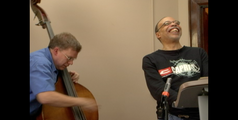Improvising Digital Culture: A Conversation
Vijay Iyer, Paul Miller
Published: 2009-12-05
The transcript of this actual discussion (from the 2008 Guelph Jazz Festival Colloquium) between musician-authors Vijay Iyer and Paul D. Miller continues a virtual discussion carried out in the pages of a collection of essays which Miller edited, entitled Sound Unbound: Sampling Digital Music and Culture (2008). Both Iyer and Miller contributed essays to that volume, and here they turn up the volume on their respective notions of improvisation, sometimes converging and sometimes diverging in interesting ways. In that earlier text, Miller presents a kaleidoscopic verbal collage of anecdotes and theoretical snippets to invoke the nature of his anthology-cum-mixtape: “Sound Unbound is about volume—of content as sound bite, of attention with no definite deficit, of memory as a vast playhouse where any sound can be you. Press 'play' and this anthology says ‘here goes’” (Miller 9). Miller employs a similarly play-ful mode of presentation in his dialogue with Iyer, and like their ostensible subject matter (improvising digital culture), Iyer and Miller remix and sample ideas and arguments from a broad collage of 20th Century cultural and political traditions. The conversation, complete with its “vexations” (to cite an Eric Satie composition that Miller brings up in the following pages), transformed into a compelling musical dialogue later in the eveningwhen the duo performed in a concert setting at the Festival. One feature of the discussion that particularly interests us is the distinction drawn by Iyer and Spooky between what it means to improvise in broad social terms versus improvisation understood primarily in musical or artistic terms, and the difficultly in separating those categories. As Iyer states in the beginning of the dialogue, many musicians from this “Great Black Music” tradition (as the members of the Art Ensemble of Chicago dubbed it) have noted that improvisation is a necessary survival tool, and their music functions as a sonic and artistic version of daily improvisational practice: “In other words,” Iyer asserts, “you might say that there are degrees, layers or levels to what we call ‘improvisation.’ There's a primal level at which we learn how to just be in the world, and then there's another level at which we're responding to conditions that are thrust upon us.” Based on this provisional definition of what it might mean to improvise, Iyer’s comments set a slightly cautionary tone to the conversation, which Miller proceeds to remix into a tricksterish set of variations on a theme. As Miller puts it, “I think the dialogue between me and Vijay here is not only between different systems of production of music, but how improvisation itself is the bridge between radically different compositional strategies.” Moderated by Globe and Mail music critic Carl Wilson, the discussion traversed about an hour’s worth of give and take, listening and collaborating, between two of today’s most important musical voices (both of whom are also, it bears repeating, devoted to actively constructing their own definitions of what they do as musicians via a wide range of published writings). The collaboration also featured a few responses to the colloquium audience members’ questions, exemplifying the kind of call and response at the heart of both analogue and digital improvisations.
Available Files
-
Improvising_Digital_Culture.pdf
Download


